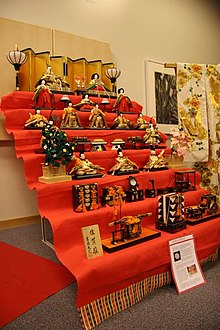Hina-Matsuri
Hina-Matsuri ( Japanese 雛 祭 り ) or Girls' Festival is a Japanese festival day celebrated on March 3rd each year .
In the period before this day, a set of dolls ( 雛 人形hinaningyō ), dressed in traditional kimonos and the emperors, empresses, servants and musicians in official court clothes , are placed on stepped platforms covered with red cloth ( 緋 毛氈 hi-mōsen ) represent.
Order of the dolls
O-Dairi-sama and O-Hina-sama
In the top row of the platform are two dolls wearing court clothing from the Heian period and representing emperor and empress. The emperor's doll is called O-Dairi-sama (お 内 裏 さ ま) and the empress O-Hina-sama ( お 雛 さ ま ) ( Dairi means "Imperial Palace", Hina means "doll"). Often these two dolls are also placed in miniature houses.
Sannin Kanjo
On the second level from the top there are usually three puppets ( 三人 官 女 sannin kanjo ). They are ladies-in-waiting who serve the emperor and the empress; B. One of the ladies holds a sake container in her hands.
Gonin Bayashi
On the third level there are five musicians with musical instruments ( 五 人 囃 し gonin bayashi ).
More rows
A variety of miniature furniture, trolleys, etc. is shown on all other levels. Sometimes the figures of two ministers are placed on the fourth step to the right and left.
origin
The custom of exhibiting dolls has its origins in the Edo period . It was believed that the dolls had the power to trap evil spirits in their bodies and thus protect the owner from dangerous encounters. In Hinanagashi ( 雛 流 し , float dolls ), paper dolls were drifted down a river into the sea in a boat, which the evil spirits were supposed to take with them.
Customs
The common drink for Hina-Matsuri is Amazake , a sweet, very low-alcohol drink made from grains. Traditionally colored arare , bite-sized biscuits that are seasoned with soy sauce, are eaten.
Every traditionally oriented Japanese family with a daughter has a set of dolls.
A legend about the Hina-Matsuri has it that the girl in a family who forgets to clear away all the dolls before the night of March 4th will not get married this year.
See also
- Kodomo no hi (the equivalent for boys)
- Holidays in Japan
- "Yume" by Kurosawa Akira
literature
- UA Casal: The Doll Festival, Being a paper read at the Kobe Women's Club on Tuesday, March 1st, 1938 . Self-published, Kobe 1938, 19 pp.
- UA Casal: The five sacred festivals of ancient Japan: Their symbolism & historical development . Sophia University, Tōkyō 1967.
Web links
- Hina-Matsuri. web-japan.org - Kids Web Japan (English)
- ginkoya.com - page with information and pictures about the Hina-Matsuri (English)
- Hina matsuri. A Japanese girls' festival. (PDF) Master's thesis, Humboldt University Berlin (German)

